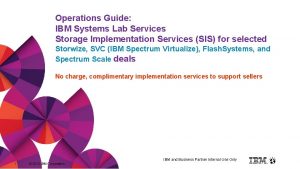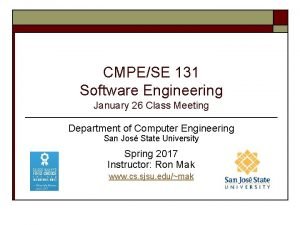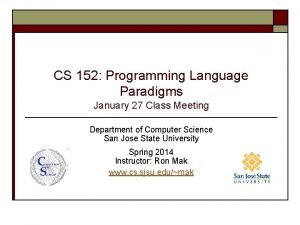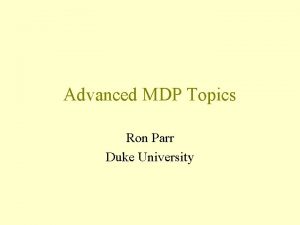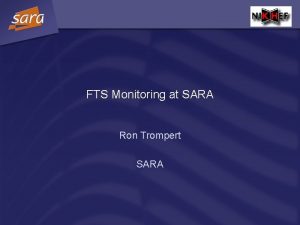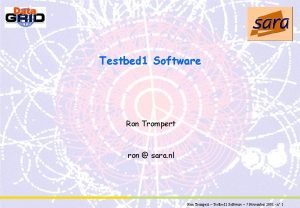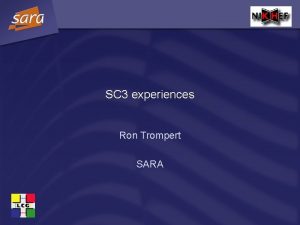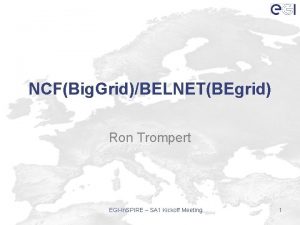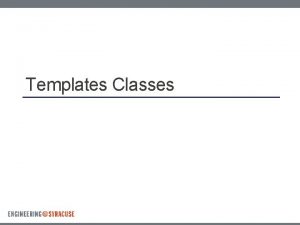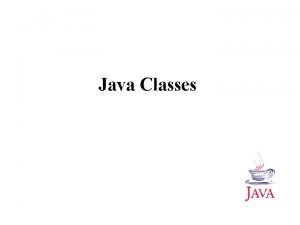Storage Classes Implementation SARA Ron Trompert SARA Storage















- Slides: 15

Storage Classes Implementation @ SARA Ron Trompert SARA

Storage Infrastructure gridftp rfio dmput

Hardware Pool nodes (NAS) 5 x dual Opteron’s, 4 GB memory, 2 x 1 GE 4 1. 7 TB disk cache, SATA, RAID 6, XFS 10 x dual opteron, 4 GB memory, 2 x 1 GE 4 6. 4 TB disk cache, SATA, RAID 6, XFS d. Cache admin node dual Xeon, 4 GB memory, 2 x 73 GB internal disk, 2 x 1 GE MSS clients (CXFS/DMF) 2 x dual Xeon, 4 GB memory, 2 x 73 GB internal disk, 2 x 1 GE, dual HBA FC, 1. 6 TB CXFS filesystem (SAN shared filesystem) MSS server (CXFS/DMF) 4 cpu R 16 K MIPS, 4 GB memory, 12 x FC, 4 x GE, 2 x 36 GB internal disk, 1. 6 TB CXFS filesystem (SAN shared filesystem), 3 x STK 9940 B tape drives Network dedicated 10 GE network between CERN – Amsterdam GE internal network between pool nodes and MSS clients nodes Tape libraries STK SL 8500 in Almere STK Powderhorn in Amsterdam

d. Cache Pools Tape pools are read/write/cache pools and disk-only pools are read/write pools No distinction between processing pools and transfer pools Avoid pool 2 pool copies All pool nodes run a gridftp door Limited number of pools per node (i. e. ~4) Control the number of movers/load on the pool node

d. Cache Pools dedicated to VOs At least for the ones that move a lot of data Possible to do have dedicated pools for groups/roles within a VO Provides “quota” Easy to get usage data per VO/group/role from d. Cache without doing “du –ms”

LAN or WAN Pools Resources of the SARA/NIKHEF T 1 will reside at both SARA and NIKHEF which are separate institutions with their own domain. =>All pools are WAN pools

Data Migration Facility (DMF) Migrates data to tape and back Automatically migrates data to tape when a filesystem usage exceeds a high water mark. Then data is being written to tape until a second lower threshold in the filesystem usage is reached. Also possible to enforce migration to and from tape (dmput/dmget)

Data Migration Facility (DMF) DMF can set different policies related to migration rules per file system and “SELECT_MSP” rules SELECT_MSP: Map uids to volume groups which is the same as tape sets Select number of tape copies per uid Uid is not necessarily the uid the VO/group/role is mapped on but the uid used to copy data from the dcache pools to the cxfs/dmf clients

Data Migration Facility (DMF) Tape drives can be assigned to volume groups Pool of empty tapes is not yet assigned to a volume group are available for everyone A tape only contains data belonging to a single volume group Performs defragmentation. Partially filled tapes are merged to create as many new empty tapes as possible

Data Migration Facility (DMF) It collects write requests and mounts a tape when a sufficient amount of data can be written to tape at a rate close to the optimal rate of 30 MB/s per 9940 B drive. Collects read requests and minimises the number of necessary tape mounts Read requests should be submitted within a limited period of time.

Storage class implementation Currently: T 0 D 1 with non HSM dcache pools at srm: //ant 1. grid. sara. nl: 8443/pnfs/grid. sara. nl/disk/ T 1 D 0 with HSM pools at srm: //srm. grid. sara. nl: 8443/pnfs/grid. sara. nl/data/ T 0<->T 1 transitions will not (yet) be supported and T 1 Dx transitions are only DB operations These transitions not involve the site’s implementation T 1 D 0 ->T 1 D 1 does not involve immediate staging of a file. However, we would still need some advanced way of scheduling staging requests (VO/group/role based) in order to avoid (unintentional) DOS attacks on the tape system

d. Cache-DMF mapping Migration script called by d. Cache uses the owner of the files to get a uid attached to a specific volume group (tape set) from a hash table Up to now we don’t use the d. Cache storage group info that is contained in the path in PNFS for this but it is possible to do so in the future It is also possible here to take the user description of the space token into account when it is passed on to this script Migration script copies the data to the cxfs/dmf clients as this uid

File Naming on MSS The path in pnfs of a file is reflected in the path on the cxfs clients. For example: /pnfs/grid. sara. nl/data/atlas/saratest/testfile becomes /cxfs/TIER 1 SC/tape_storage/0003/data/atlas/saratest/testfile: : 00 03000000068 ECE 8 Easy to get information about the owner/type of data and the corresponding pnfsid

Remove files from MSS Remote path on CXFS clients is stored in PNFS when file is copied Cron jobs collects that info about removed files from /opt/pnfsdb/pnfs/trash/1 and removes the file

d. Cache prestager Every minute a cron scripts collects files queued for restore “rh jobs ls” for all tape pools to see what restore requests are queued and which files are involved Scripts issues a dmget for these files
 Classe subclasse
Classe subclasse Pre ap classes vs regular classes
Pre ap classes vs regular classes Ibm systems lab services
Ibm systems lab services Primary storage and secondary storage
Primary storage and secondary storage Secondary storage provides temporary or volatile storage
Secondary storage provides temporary or volatile storage Object based and unified storage
Object based and unified storage Primary storage and secondary storage
Primary storage and secondary storage Sjsu cmpe 131
Sjsu cmpe 131 Cs152 sjsu
Cs152 sjsu Exclamatory sentence
Exclamatory sentence Ron parr
Ron parr Hermione and ron kids
Hermione and ron kids Ron doria
Ron doria Ron grigg
Ron grigg Ron muhlenkamp
Ron muhlenkamp Ron ashkin
Ron ashkin


